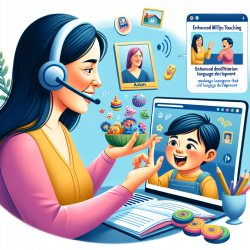Introduction
Music is a ubiquitous element of human culture, and its influence on development begins early in life. Recent research by Mendoza and Fausey (2021) highlights the significant role of everyday music in shaping infants' sensory experiences and developmental trajectories. This blog post aims to translate these findings into actionable insights for speech-language pathologists (SLPs) working with young children, encouraging data-driven approaches and further research into the therapeutic applications of music in early childhood.
Understanding the Research
The study "Everyday Music in Infancy" provides a comprehensive analysis of the musical environments encountered by infants aged 6-12 months. Using daylong audio recordings, the researchers identified patterns in the types of music infants are exposed to, noting a prevalence of recorded instrumental music and live vocal music. Importantly, they found that infants' musical experiences are non-uniform, with certain tunes and voices being significantly more prevalent than others.
Implications for Speech-Language Pathology
For SLPs, these findings underscore the importance of considering the auditory environment in therapeutic settings. Here are several ways practitioners can integrate these insights into their practice:
- Incorporate Familiar Tunes: Use familiar tunes and voices in therapy sessions to enhance engagement and retention. Familiarity with certain musical patterns can aid in language acquisition and cognitive development.
- Leverage Live Music: Encourage caregivers to sing to their infants, as live vocal music has been shown to capture infants' attention and promote interaction, which is crucial for language development.
- Vary Musical Exposure: Introduce a variety of musical genres and instruments to broaden infants' auditory experiences. This diversity can support the development of auditory discrimination skills and cognitive flexibility.
Encouraging Further Research
While the study provides valuable insights, it also opens the door for further exploration. SLPs and researchers are encouraged to investigate the following areas:
- Longitudinal Studies: Examine the long-term effects of early musical exposure on language and cognitive development.
- Cross-Cultural Comparisons: Explore how different musical environments across cultures influence developmental outcomes.
- Individual Differences: Investigate how individual differences in infants' responsiveness to music affect developmental trajectories.
Conclusion
The integration of everyday music into speech-language pathology practices holds promise for enhancing therapeutic outcomes. By understanding and leveraging the natural musical environments of infants, SLPs can create more engaging and effective interventions. As we continue to explore the intersections of music, language, and development, we encourage practitioners to remain informed and contribute to this growing body of research.
To read the original research paper, please follow this link: Everyday music in infancy.










